
Here at ScriptPhD.com, we pride ourselves on being different, and we like thinking outside the mold. So for Earth Day 2010, we wanted to give you an article and a perspective that you wouldn’t get anywhere else. There is no doubt that we were all bombarded today with messages to be greener, to use less, to be more eco-conscious, and to respect our Earth. But what is the underlying effect of advertising that collectively promotes The Green Brand? And has the Green Brand started to overshadow the very evil—environmental devastation—it was meant to fight to begin with? What impact does this have on the future of the Green movement and the advertising agencies and media that are its vocal advocates? These are questions we are interested in answering. So when we recently met Matthew Phillips, a Los Angeles-based writer, social media and branding expert, and the founder of a new urban microliving movement called Threshing, we were delighted to give him center stage for Earth Day to offer his insights. What results is an intelligent, esoteric and thoughtful article entitled “Plastic Beads and Sugar Water,” sure to make you re-evaluate everything you thought you knew about going green. We welcome you to contribute to (and continue) the lively conversation in the comments section.
“Access to land provides access to food, clothing, and shelter—which means access to land provides the possibility of self-sufficiency—if anyone wants to maintain a dependent (and therefore somewhat dependable) workforce, it’s crucial for you to sever their access to land. It’s also crucial that you destroy wild foodstocks: why would I buy salmon from the grocery store if I could catch my dinner from the river? Now, with people having been effectively denied access to free food, clothing, and shelter, which means having been effectively denied access to self-sufficiency, if they are going to eat, they’re gong to have to buy their food, which means they’re going to have to go to work to get the cash to buy what they need to survive. If you’re a corporation, you’ve got them where you want them.” —What We Leave Behind.

I have a great deal of admiration for our original permaculture engineers, the American Indians, all grass fed bison advocates. Looking back, we can’t imagine how naive or gullible they were to accept fire, water, plastic beads and useless trinkets in exchange for their healthy animals, fresh fruits and vegetables, consulting knowledge, and land—whose value is incalculable. Interestingly, here we are 518 years later, and we’ve all been duped into giving up our valuables for well marketed sugar water, and filtered tap… in plastic bottles.
After 1492 the American colonization effort was dominated by the European nations. In the 19th century alone, 50 million people left Europe for the Americas with ‘old world’ diseases, and a manifesto to massacre, obliterating 42 million American Indians. Everything changed; the landscape, population, plant and animal life. A few pioneers with rebel attitudes proved they could kill, conquer, and dominate an entire people and their land. What have we learned? When you deprive a group of people access to their land, you dominate and control their self-sufficiency, and ultimately their sustainability.
Earth Day was designed from its inception, April 22, 1970, to inspire awareness and appreciation for the Earth’s environment. Like all successful grassroots movements, Earth Day continues to self-organize and experiences annual growth. Over the years, it has propagated thousands of related causes or brands. This celebration gives us the opportunity to contemplate how to purchase food and drink that are produced locally through natural, sustainable methods. Whether we graze together, or barbecue grass-fed bison, I anticipate that many foodborne conversations will thresh organic ideas that seed new urban backyard businesses, and energize sustainable causes.

In fact, in this past year, we have witnessed local production and sustainable social causes grab the wheel from the generic “Green” brand. ‘Local and sustainable’ terms have the potential to drive significant impact in helping redefine a movement whose banding terminology is arguably out-of-focus. The Green goal has not achieved our Garden of Eden fantasy. Many generic Green causes have become distracted watching, and often joining, the fight against their ‘evil,’ instead of cultivating community and encouraging positive purposeful action. We’ve seen new Green causes sprout through PR dusting designed to crowd out similar already established causes. There’s nothing wrong with competition, seeking a bigger audience, news, press, and ultimately funding, but often the next new Green cause articulates greater Green evils in an attempt to further establish its reason to rally. This problem is churned up further with traditional reports broadcasting emotionally charged sound bites. Reporters often don’t take the effort to dig past the easy emotional approach, and into the rich cream of the cause itself. It is much easier to philosophize about the negative, which can feed our illusion of intellectual superiority, but it’s really keeping our callus-free hands from getting dirty planting GM-free maze in the garden and producing oxygen. “The creation of something new is not accomplished by the intellect but by the play instinct acting from inner necessity. The creative mind plays with the objects it loves,” said Carl Jung.
A great brand seeks to unify in a cyclical system: Magnetizing believers, educating, generating action, and finally producing evangelists, who then magnetize new believers and so on. Memorable brands are most effective when they are communicating their power and concept through story. At its most basic, a brand’s story is made up of the hero, (relating to the brand’s reputation and hopefully positive recognition), and its evil, (the perception of what hinders recognition of the brand). Clarifying the adversaries of the brand can help to ‘rally the troops,’ codifying their cause and movement. Without an adversary, it’s often difficult to get enough of a rouse from fellow partners to get anything started.
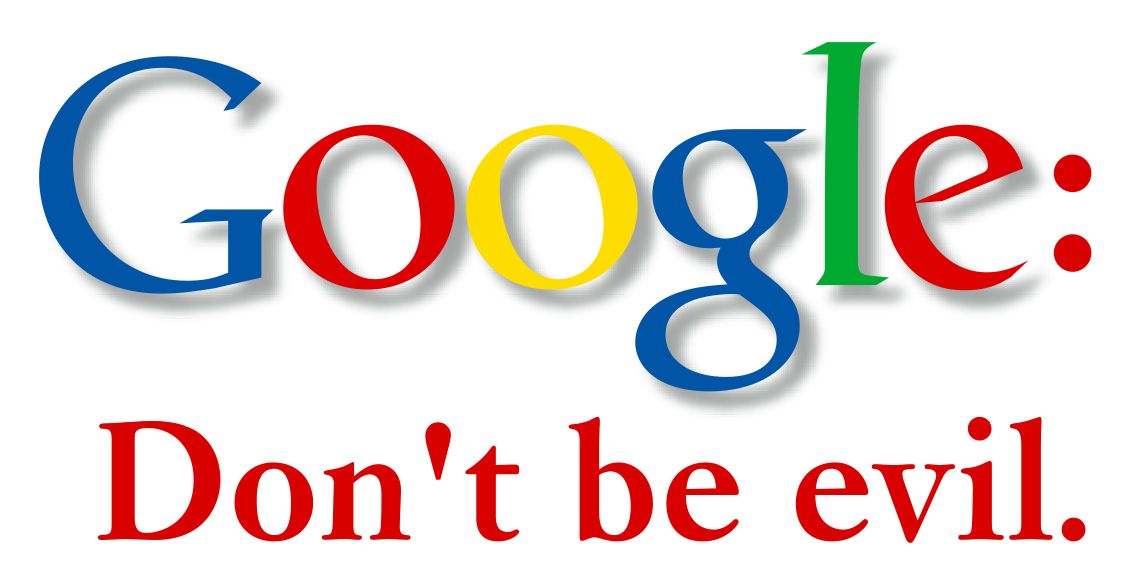
Every great brand needs an evil to fight, but Green’s evil has metastasized into the most unimaginable catastrophe that no cause could ever compete against—an over heating planet. Since it doesn’t get much worse than a gooey globe due to our ongoing abuse, this heat enemy seemed guaranteed to become THE unifying force, an evil that we could all fight together to overcome. The problem is the scope is too large to control or confine. It has mutated. Proving global warming has the potential to fracture the green community, and along the way has produced a number of serious critics. Terms like ‘climategate,’ and climate skeptics like Doug Keenan, continue to look at research they say is embellished to promote climate change. Maybe worshiping the over heating demon has made the ‘Green’ brand seem boring compared to the excitement of the fight. Google never defined its “Don’t be Evil,” last minute tag, which is part of the reason it continues to generate conversations across the board. Google has essentially allowed all of us to insert our own definitions of evil, which in effect has unified greater numbers to their brand. A very novel approach.
If the evil of a brand consistently gains more press than the cause, then the evil assumes and replicates the identity of the brand. When this happens, the brand is no longer the host. When the evil forcefully sucks all the nourishment from the brand’s beating heart, then the evil we were fighting becomes the cause. We feel more comfortable with our fingers on the keyboard dealing intellectually with evil, which in effect, removes our foot from the shovel of physical, sweaty action. Do we want to get back to the heart of the brand, the original cause? Harley Davidson, once perceived as the brand of choice for rebels and tattooed ex-cons, re-branded itself and become the hog of choice for everyone who could scrape together enough money, regardless of prison experience, body type, tattoo placement, or gender. Even our kids wear official HD branded fashion with pride.
If we stop promoting the evils, real or manufactured, and start encouraging positive actions and solutions, (often positive action is the best offense against perceived evil anyway) we’ll find passionate people that want to join us in healing our people and planet. The strategic approach to refresh a brand is extremely important if it is to succeed. Digitally empowered consumers want to punish those that don’t behave in a socially responsible way and reward those that do. Social media has given people real power to act, and also to be negative. “Social media is inherently more negative than a positive medium on many levels,” said David Jones, the global chief executive of Havas Worldwide. “Lots of stuff that is passed around is negative. If you are a brand or a company today you should be far less worried about broadcast regulations than digitally empowered consumers.”
Many will continue to base their directive on creating new enemies, using ‘the fight’ to impassion those around them to rally their cause. Stop depleting the ozone layer, reduce your carbon footprint, global warming. All grand Green, but terminology that is technically fear-focused. We’ve heard the pitch: “It is your investment of $59.95 that allows us to partner together to fight this injustice.” The fear based, negative approach is almost always wrong, (unfortunately, it can be effective) . It’s a slippery slope, and those who don’t fully embrace the creed, are either stamped ‘stupid,’ or ostracized. But sustainability should be positive at its core. There is a time to debate, and we’ve debated ourselves into the greatest recession any of us have ever experienced. It’s time to stop debating.

Let’s begin by forming communities that build sustainable ventures together. If we are fighting, or politicking, we are not building. “We have become divided into so-called red and blue states, an outcome directly traceable to the urban-rural division of our society. This is something of a simplification, but food producers and their social allies tend to vote red and food consumers and their social allies tend to vote blue. The division is thought to be between conservative and liberal philosophies, but it much more reflects the difference between rural and urban values,” said Gene Logsdon.
There are two real challenges within the sustainability movement:
1) Consumers’ decisions (especially with food) are splintered by: A) Convenience, B) Tradition, C) Bias, and D) Beliefs.
2) Industry’s “manufactured demand” is affecting consumers with: A) Deceptive advertising, B) Ambiguous terminology, C) Perfectly designed plastic convenience packaging sealing our addictive lifestyles.
The minute we wake up we are subjected to an eco-plastic, part of this complete breakfast, 100% edible, industrialized high fructose corn syrup, brand campaign. Industrialized conveyor belts are pumping out a marketing product of starch coated with refined sugar. We can reignite our camaraderie by producing fruits, vegetables, animals and vehicles that not only compete, but surpass, our current available choices; all sponsored of course by our very green desire for sustainability. Incidentally, the average number of ‘green’ products per store almost doubled between 2007 and 2008. Green advertising almost tripled between 2006 and 2008. Does this necessarily mean we are heading in the right direction?
Governmental regulations for consumer protection in industrial food processing plants have only added to an already over stressed food system. This industrialized hyper-efficiency has caused diseases in animals and bugs on crops that have been taken so far out of their natural ecosystem that they can no longer produce without heavy use of antibiotics and pesticides. These measures, of course, were designed to keep us safe, but instead have become another major concern since “packaged nourishment” comes from the industrialized, often treated, food system.

Creatives are beginning to find and tell the stories concerning the overly subsidized and industrialized food and distribution system which favors use of pesticides and antibiotics. Since the government historically is not very good at spearheading movements, artists (media pioneers, authors) and social entrepreneurs will continue to fill this leadership role. We don’t have to look far to see powerful results. Thank the documentary filmmakers of Food Inc., Supersize Me, HomeGrown, The Future of Food, Story of Stuff, and Bottled Water, for helping us become visually aware of how industries have been deceiving consumers and themselves in their interest of greed and everyone’s desire for convenience. But there is hope, and it’s simple. Consumers are communicating online like never before, this leads to uniting together to strategically direct where we spend our hard earned bread and where we plant or raise our own food.
Jamie Oliver’s new TV series, The Food Revolution, has exposed the frozen fat underbelly of pre-packaged (brown and gold) foods, and government charts that officially dictate the clogging of our kids in school. Local and “real” food production and consumption has become a legitimate genre, with universities, and high schools requiring reading of titles like Barbara Kingsolver’s Animal, Vegetable, Miracle, Michael Pollan’s Omnivore’s Dilemma, Bill McKibben’s Deep Economy, among others. These authors are helping us move past intellectual reasoning and into action. Since Timothy Ferrass taught us how to achieve a four hour work week, some of us among the fortunate now have the extra time to plant some seeds, water, and grow great big vegetables, and share them with our friends and neighbors.
I believe that in the next decade we will see less of an emphasis on extrinsic, materialistic values and more on intrinsic, spiritual values. This shift in emphasis will begin to bear fruit with the collaborative grafting between creative media pioneers and social entrepreneurs who seek to disrupt the status-quo. Research from San Francisco State University has shown that experiences bring people more happiness than material possessions. Experiences shared with others continue to provide even greater happiness through memories long after the event occurred. I believe many social entrepreneurs and creative media pioneers, in their hearts, believe their core purpose is to encourage our return to a sustainable world ecosystem. In other words, many will forgo Hummer-sized riches in order to nurture the successful adoption of their creations into society. There remains however ambiguity in the complexity that lies between the producer and the consumer. The ancient system of distribution gives middlemen the leverage to manipulate both producers and consumers. This too is evolving, as producers return to their roots and begin to distribute locally. There is change in the air, spring is coming.
We are at such a nascent stage in the evolution of the sustainable movement. The infrastructure necessary for the modern city to relocate to the farm is exorbitant, but the farm is beginning to integrate into the metropolis, one yard at a time. ‘Off the grid’ produces many wonderful connotations. It is an adventurous subject, one that I’m convinced will help propel this branding conversation forward. I wonder who else is discussing the connections of the ideas from this article, and from the authors and media pioneers mentioned? Who are the artisans, and social entrepreneurs that are working on this? Very curious about your thoughts. Please don’t hesitate to email me, and please act.
Let’s continue to find new ways to unify this brand with wonderful heart felt stories about the adventures of locally produced products, urban farms, and sustainability.
Writing this has given me a renewed appreciation for early American Indian cave drawn stories of food: adventure, and victory. There is more there than I had imagined.
Matthew Phillips is a media producer, writer and technologist working in Los Angeles, CA. He is the producer of Threshing.
*****************
ScriptPhD.com covers science and technology in entertainment, media and advertising. Hire our consulting company for creative content development.
Follow us on Twitter and our Facebook fan page. Subscribe to free email notifications of new posts on our home page.
]]>
Happy Earth Week 2010, everyone! Here at ScriptPhD.com, we have devoted a number of articles to environment, sustainability and eco-awareness as part
of our continuing “It’s Not Easy Being Green” series. This year, in celebration of the 40th anniversary of Earth Day, we are devoting the entire week to articles, interviews and profiles of companies, individuals and content that raises awareness of sustainability efforts and new ideas for the green science revolution. Because water lies at the heart of most modern environmental crises, we kick off Earth Week with CaptainPlanet’s review of the stellar new DisneyNature documentary Oceans, a truly spectacular oeuvre that celebrates the majesty of our most important and delicate resource. We also include a number of practical, easy things you can do right now to make a difference globally by acting locally. For our Oceans review and to find out what you can do to help protect our Earth’s water supply, please click
the “continue reading” cut.
When I was three years old, my parents took me on a vacation to Atlantic City. It was my first time ever to see the ocean, and my parents were excited to see my reaction at seeing the water when we arrived at the beach that morning. Although I don’t remember the experience, I’ve been told that when I first set foot on the beach, I had a very concerned look on my face when I saw the waves pounding the shore. I ventured closer to the water to get a closer look, and upon surveying the incoming waves, I promptly turned on a dime and outran my parents back to the hotel without stopping. When my parents finally caught up with me to find out the reason for my distress, I said, “the river came out of itself,” in awestruck horror at the ocean’s power.
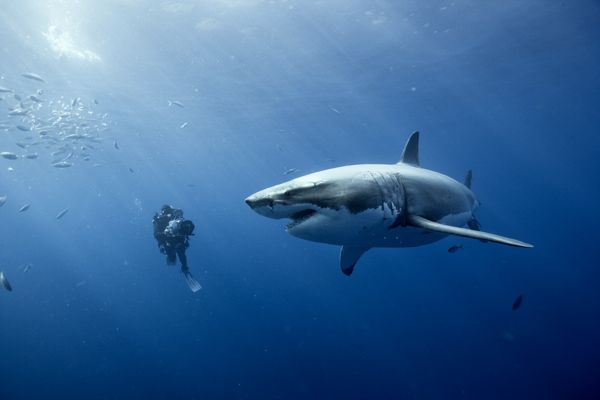
Oceans, a DisneyNature documentary premiering in theatres on Earth Day, April 22, 2010, opens on a similar theme of childhood wonder as a little boy on a beach stares out at the vastness of the ocean before him and wonders what an ocean is. As children, before we learn names for what things are called, and prior to learning about taxonomical categories in biology courses, staring at an ocean and all of its inhabitants is truly an exercise in wonder. Oceans ignites that childlike wonder while exploring the richness, beauty, danger and primordial nature of the sea. Directors Jacques Perrin and Jacques Cluzaud clearly have a knack for inciting wonder. Perrin directed the acclaimed The Winged Migration in 2001 and Cluzaud’s resume features work in IMAX films and innovative projection techniques.
Disney launched the DisneyNature label after the worldwide success of March of the Penguins in 2004. Their mission is to release one nature-related documentary per year to raise awareness about the interconnectedness of humans and nature, including what actions we can take to positively impact the environment. It is promising to see a global media corporation as hefty as Disney champion sustainability in a serious way. And it will be clear to anyone who sees Oceans, a top-notch production with stunning cinematography, narration and musical score, that Disney spared no expense to produce this film.
Pierce Brosnan, the film’s narrator, seems to have found a daft second career in narration, starting with his excellent work on the pre-recorded audio tour of the 2006 Magritte exhibit at the Los Angeles County Museum of Art. Brosnan’s voice, retaining the suaveness of his 007 days, guides us on a journey through waters of the globe. It seems at times as though the film has managed to capture every single creature that inhabits the oceans, as impossible as that would be. From whales, dolphins, sharks, sea lions, polar bears, otters, fish, crabs, shrimp, plankton, turtles, to penguins, octopi, jellyfish, and many more, it’s easy to forget just how many members of the animal and plant kingdom reside
in the oceans.
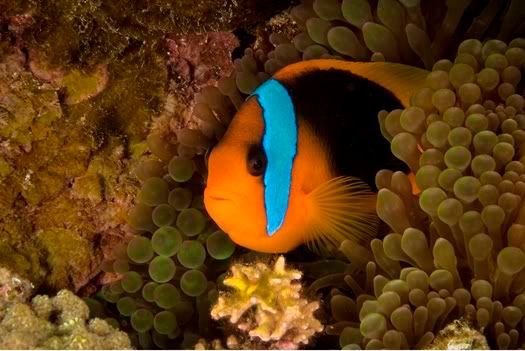
In one of the film’s most breathtaking sequences, we witness a school of sardines massacred from above and below by an army of birds, dolphins, sharks and blue whales. The sequence is an orgiastic feeding frenzy, shot from above, on the surface and underwater, accompanied by a kinetic musical score. The different animals in this sequence appear so choreographed that they invoke the ballet of dancing hippos, ostriches and alligators from the “Dance of the Hours” sequence from Disney’s animated Fantasia masterpiece. The sequence ends with a blue whale breaching the surface in the center of concentric rings of dolphins, fish and birds, a prima ballerina taking her bow.
Oceans is primarily a love letter to our world’s oceans, surveying the various topographies and lifeforms of the world beneath the surface that we often take for granted. Fortunately the film doesn’t shy away from discussing the danger that human activity poses to oceans. Although Oceans was never intended to be a hard-hitting piece of environmental journalism, it does strike a good balance between education and advocacy. The film highlights how advances in satellite imagery allow us to see where industrial pollution flows from rivers out into the open ocean, much the same way a calcified artery might appear on a heart scan. In a regular satellite photo, the river appears to be as blue as the ocean, but when the view switches to the new technology, the pollution in the river, heretofore unseen, materializes in the photo as a black, foreboding stream. The oceans have become humanity’s dumping ground for hundreds of millions of tons of trash each year. In another sequence, we see gigantic fishing nets that sweep vast swaths of water, a practice known as trawling, decimating global fish populations and killing other animals unlucky enough to get caught in the vast net. And in Antarctica, we are shown how rising global temperatures have resulted in the demise of the polar ice caps. Though the film doesn’t broach the topic directly, human water consumption is another imminent crisis facing our oceans. In a brilliant editorial, National Geographic Society chairman Gilbert Grosvenor discusses how human water usage is unsustainable and touts a National Geographic issue devoted entirely to water. (Download here.) Towards the end of Oceans, Brosnan boldly (and correctly) states that the greatest threat to the ocean is human indifference. We hope that you attend, absorb and engage in activism, even at the most basic levels to prove him (and all of us) wrong.
Coinciding with the film’s release, Disney has launched a campaign, in partnership with The Nature Conservancy, to create a protected area of coral reef in the Bahamas. Each moviegoer who attends an Oceans screening in the first week of the film’s release will help contribute to the cause. The campaign for the previous DisneyNature release, Earth, resulted in the planting of an astonishing 2.7 million new trees in the Amazon rainforest. The Nature Conservancy, founded in 1951, protects more than 119 million acres of land, 5,000 miles of rivers, and 100 marine conservation projects globally. With a staff of more than 700 scientists, they pursue their goals through science-based, non-confrontational strategies.
Oceans Trailer:
Oceans goes into wide release on Earth Day, April 22, 2010 at theatres nationwide.

•Contact your congressional representatives to voice your support for the Oceans-21 Act: a bill that adopts the key recommendations of the U.S. Commission on Ocean Policy and the Pew Oceans Commission to develop a holistic ocean health plan. This bill, unlike past ocean legislation, treats the disease, not the symptom.
•Educate yourself about the sustainability of seafood. Check out “Bottomfeeder: How to eat ethically in a world of vanishing seafood” by Taras Grescoe.
•Check out the Monterey Bay Aquarium’s guide to seafood
•Volunteer or donate to ocean related organizations. If you live by a coastal area, attend a beach clean-up.
•If going on a cruise, choose an environmentally friendly cruise line
•Support elected officials who support the ocean.
•Keep trash out of the oceans—if you don’t already, recycle, reduce, reuse and compost as much of your waste in your home and office as possible. Earth911.com is an exceptional resource for tips on recycling, finding ways to be greener, reduce waste, and purchase products made of recycled materials.
•Have more ideas for us? We’d love to hear about them in our comments section.
CaptainPlanet is an LA-based, Northwestern University-educated, eco-charged sustainability guru who loves film, psychology and saving the planet, one waterless urinal at a time…
~*CaptainPlanet*~
*****************
ScriptPhD.com covers science and technology in entertainment, media and advertising. Hire our consulting company for creative content development.
Follow us on Twitter and our Facebook fan page. Subscribe to free email notifications of new posts on our home page.
]]>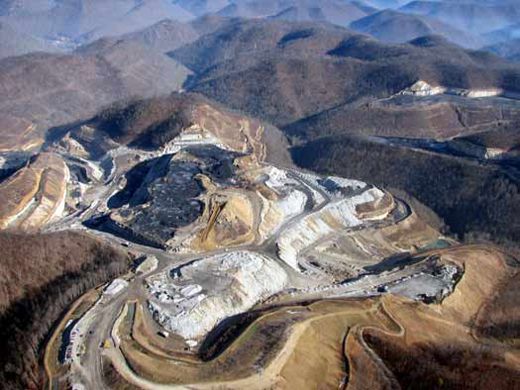
One of the most pressing issues of our time is how and where we are going to get sustainable energy for a global population with a rapidly rising standard of living and the consumption that this entails. Approximately 10% of United States coal production [coal in general accounts for 40% of global electricity production] is procured through mountaintop removal, an environmentally-devastating extraction that literally involves blasting off (or removing) the top of a mountain to extract the coal inside. The practice gained popularity in the 1960s, when it started becoming too difficult and too costly to extract coal from underground mines. In our continuing “It’s Not Easy Being Green” series, ScriptPhD.com’s eco-blogger Captain Planet talks about the documentary Mountaintop Removal, exactly what it entails, and why this process is so much more costly than the immediate energy gained from it. Please click “continue reading” for more.
“Take away wilderness and you take away the opportunity to be American.” –Roderick Nash, from ‘Wilderness and the American Mind’
If you were wondering where the sets for the land of Mordor were filmed for the Lord of the Rings trilogy, the answer would be New Zealand. But after viewing Mountaintop Removal, a well done, if homely, documentary currently in rotation on PBS and a film festival darling, the answer could just as easily have been a coal mining site in West Virginia.
So begins the story of Mountaintop Removal, with shaky aerial shots of mountains which, as you may have guessed by the name of the film, have had their tops removed. The resulting carnage of mountaintop removal is horrific in its environmental damage, toxic impact on human health, and permanent mutilation of a once-beautiful geography. As the film is quick to point out, you can cut down a forest, and eventually, it could grow back. But when you slice off the top of a mountain and extract all the coal inside, the mountain doesn’t grow back. Ever. What was once idyllic countryside in the Appalachian Mountains is quickly becoming a nightmare of epic proportions. To date, mountaintop removal has destroyed 1,000,000 acres in the Appalachian area.
The dirty secret behind goal is that it comprises 50% of the USA’s energy production. Burning coal is the cheapest way we know of to produce electricity, but it is also the most harmful in terms of the amount of carbon dioxide it produces, hastening the rise of the planet’s thermostat. Jeff Goodell, a coal specialist and author of Big Coal, says in the film that when he first started researching coal, he was surprised that we actually still use it today. He thought it had gone the way of the horse buggy and top hat. “I thought that electricity was just something that flowed down from a golden bowl in the sky. I never gave any thought to where it came from.”
So where does it come from, and how does mountaintop removal work, anyway? The organization Aurora Lights.org has an exceptional collection of information about mining, coal removal and alternative energy, and is a great resource for in-depth information. In essence, the practice of mountaintop removal is a five-part process. It begins with clearing, literally razing, burning and deforesting the trees to provide an unobstructed mining path:

The process continues with blasting, usually involving the use of dynamite to clear away earth and rock above the coal seams. This process in particular releases silica and chemical-ladden dust as airborne
particles to surrounding communities:
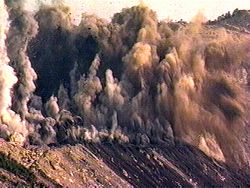
Next is the critical step of digging to clear rubble leftover from the blast and expose the coal seams directly for extraction and removal:

The rubble from the denuded mountains is dumped in the next step, called a valley fill, in which tons of rubble are relocated into the mountain’s valleys. This process has buried 1,900 miles of headwater streams (more on this below) and increased flooding during rainfall.
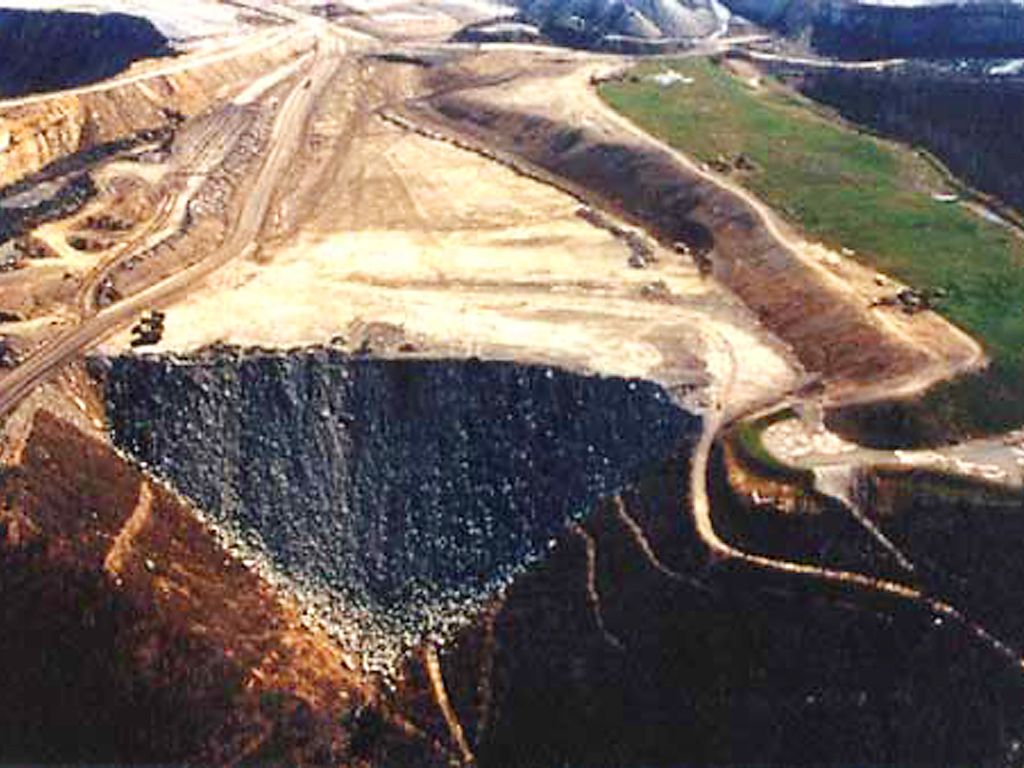
Finally, after all the coal has been mined, the barren mountainside is “replenished” reclamation, a largely superficial aesthetic process that involves planting of grass and plants, most of which will not ultimately be able to survive in the rocky ground.

If any or all of this sounds environmentally devastating, that’s because it is.
The Mountaintop Removal documentary highlights a coalition of concerned citizens who have organized to prevent further coal mining. They are comprised of college students, parents and environmentalists. The film introduces us a small elementary school in West Virginia with a coal mine in its backyard. The school sits next door to a “lake” full of coal slurry (akin to toxic sludge), which includes large volumes of lead, arsenic and cadmium. The children of the school have suffered increased rates of asthma, headaches and mouth sores, to name a few of the most common maladies. In a particularly effective scene, the parents of these school children march into the governor’s mansion unannounced and ask the Governor to relocate their children’s school to an area away from the coal mines.
The underlying issue of coal production is at the heart of our nation’s energy policy. As one interviewee so succinctly puts it in the film, we are at a crossroads where we must decide if we’re going to convert to sustainable,
green sources or continue pursuing non-renewable sources that pollute the environment and contribute to global warming. If you’ve been watching any television episodes on Hulu lately, you may have come across an advertisement for Coal River Wind. It’s a movement underway to install a fleet of wind turbines on the side of Coal River Mountain in West Virginia. It’s a race against time because Massey Energy (contact them today!), the lead coal company featured in Mountaintop Removal, has filed permits to remove the mountaintop which would destroy the wind potential. The Coal River Wind website urges visitors to write to the EPA, sign their petition and donate. It’s a microcosm of the country’s political will and long-term energy policy.
The most effective point that Mountaintop Removal ultimately makes is one of sustainability. Once the mountain ranges of Appalachia have been stripped of all coal, the coal companies will move on to other areas or dissolve. What they will leave in their wake will be broken economies, blighted landscapes and a host of health problems for anyone who is still living in the area, effectively turning the Appalachians into something like a modern-day dust bowl.
The scientific consensus on mountaintop coal mining is stunningly clear. Last month, an analysis of collected scientific studies concluded in the scholarly journal Science that mountaintop coal mining is deleterious to both the environment and human health and should be banned altogether. In all, this coal extraction process has filled 700 miles of US streams with debris, sludge and toxic pollution. Sadly, President Obama’s recent compromise with the Patriot Coal Company will steamroll [pardon the pun] a major mining project in West Virginia.
Mountaintop Removal trailer:
Websites that you can visit and organizations to get involved in to help stop mountaintop removal mining:
Coal River Mountain Watch
Ohio Valley Environmental Coalition
WV Highlands Conservancy
Mountain Justice Summer
Earthjustice
Photographer George Wuerthner has magnificently documented the ravages of mountaintop mining removal in Kentucky. The jarring mages are enough to implore you to get involved today.
CaptainPlanet is an LA-based, Northwestern University-educated eco-charged sustainability guru who loves film, psychology and saving the planet, one waterless urinal at a time…
~*CaptainPlanet*~
*******************
ScriptPhD.com covers science and technology in entertainment, media and advertising. Hire our consulting company for creative content development.
Follow us on Twitter and our Facebook fan page. Subscribe to free email notifications of new posts on our home page.
]]>
One of our most exciting continuing projects here at ScriptPhD.com is our “It’s Not Easy Being Green” series of articles, highlighting the environmental and green issues and technology solutions facing our time (see our recent Blog Action Day post). Dedicated to bringing you more in-depth and frequent green content, we are thrilled to add a new ScriptPhD contributor, CaptainPlanet, who will write exclusive movie reviews and issues for “It’s Not Easy Being Green.” He joins us with a review of The Cove, a recent documentary garnering Oscar buzz, about the secret dolphin-hunting industry in Japan and its environmental and emotional impact. If you hadn’t previously known about how majestic and advanced dolphins really are, and how deleterious the depletion of fish is across the oceanic biosphere, watch this film. ScriptPhD.com review, discussion, and ways to get involved, under the “continue reading” jump.
REVIEW: The Cove
ScriptPhD.com Grade: A
The biggest problem with The Cove, a 2009 documentary in serious contention for the Oscar, is how to describe the film in one sentence to someone without dampening their enthusiasm for wanting to see it. “It’s a movie about dolphin slaughter,” summarized director Louie Psihoyos at a recent screening in Los Angeles. The Cove is about so much more than dolphin slaughter, the filmmaker went on to say, but when you try to sum it up to someone, you’ll find yourself saying that phrase again; dolphin slaughter. Try persuading your friends and co-workers to go see a truly great film about, say, puppy murder, and you’ll soon discover the problems inherent in generating good word-of-mouth for The Cove. The good news is that the Cove is a breathtakingly good film; a suspenseful adventure in the vein of Ocean’s 11 about a small group of concerned individuals who literally risk their lives to blow the lid off of Japan’s black market of dolphin capture, killing and consumption.
The story of The Cove must be traced all the way back to 1963 with the mother of all dolphin movies, Flipper. NBC created an eponymous television series that aired from 1964 to 1967. The part of “Flipper” was played by five live female dolphins, under the supervision of one of the world’s first dolphin trainers, Richard O’Barry. One of the lead dolphins, Kathy, was sold to a major American aquarium after the series wrapped. Years later when O’Barry went to visit Kathy in her tank, he could tell that she was depressed. Kathy swam up to him, gave him a “hug,” and then turned around and committed suicide. As The Cove explains, human beings breathe automatically, but dolphins must consciously choose every breath, giving them the ability to end their own life if their conditions become unbearable. O’Barry watched Kathy’s body sink to the bottom of the tank, stunned by what he had just seen while also feeling guilty that he had not done more to lobby for her return to the wild. The next day, O’Barry was arrested at an adjacent aquarium while attempting to free another captive dolphin. Thus, an activist was born. To present day, O’Barry has dedicated his life (and sometimes risked it) to freeing captive and distressed dolphins in locations around the world, including a deceptively beautiful looking cove in the small fishing town of Taiji, Japan. He is the author of two books on dolphins, To Free a Dolphin and Behind the Dolphin Smile. For his lifetime of activism and environmental contributions, O’Barry has been a previous recipient the Environmental Achievement Award presented by the United States Committee for the United Nations Environmental Program.
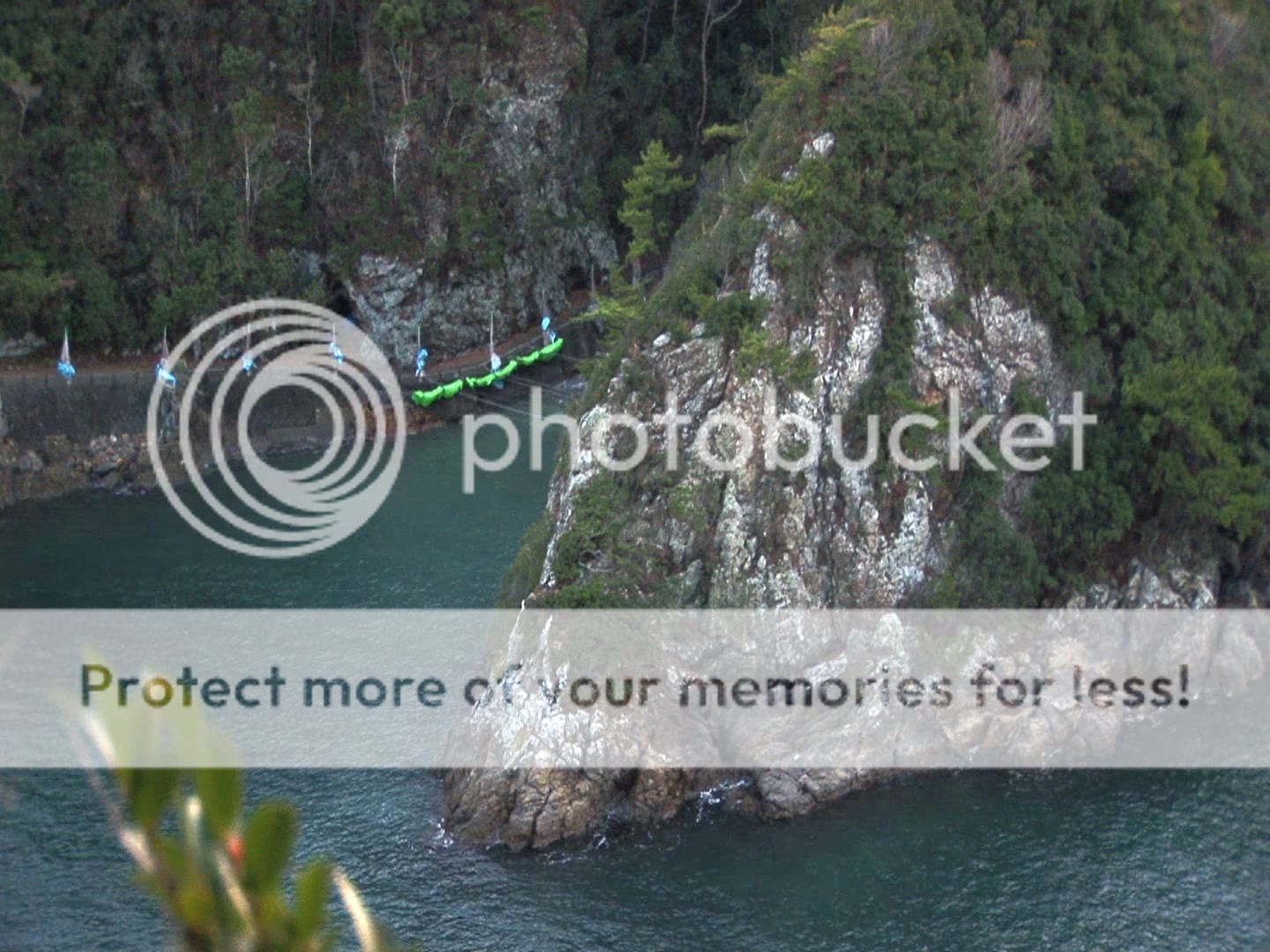
Every year from September through March, tens of thousands of dolphins migrate past Taiji, Japan, where fishermen force the animals into a cove using nets and loud noises produced by banging on underwater pipes with hammers (since dolphins’ primary communication is by sonar, they are hypersensitive to noise). To escape the noise, the dolphins swim into the cove where they are trapped. From that point, the dolphins face two scenarios: being sold into captivity or being killed for lunch meat. Each year 23,000 dolphins are killed in Taiji alone. Japan is a nation that relies heavily on seafood as a food source, and it is not uncommon to see whale and dolphin meat for sale in Japanese food markets. In one scene, the filmmakers visit the seafood section of a Japanese market. They pick up pieces of meat cushioned in white Styrofoam wrapped in cellophane from a refrigerated bin. Upon closer inspection, we see that the meat in the container is an exotic dark purple color, and when the camera zooms in to capture the label, we see that the food in hand is a piece of dolphin flank. Other meats masquerading as expensive, rare seafood were analyzed by the filmmakers in a makeshift DNA lab and also found to be dolphin. A 2006 US Geological Survey report showed that oceanic mercury levels were 30% higher than in the mid-90s. Because of this, mercury levels have been steadily rising in fish meat, but some fish contain higher levels than others. Fish that are predatory (eat other fish) are large and at the top of the food chain, and so tend to contain more mercury. Dolphins fit into this category.
For years the ignominious fate of dolphins at Taiji has gone unnoticed because there is no documented footage of the capture and slaughter, mostly due to a carefully orchestrated media blackout. Most Japanese citizens in major urban centers, as The Cove is quick to point out, are not even aware that their country participates in harvesting dolphin meat for consumption. O’Barry discovered the cove at Taiji years ago and has since spent many years trying to save the dolphins from capture or death. His efforts have been thwarted time and time again by the local Taiji government, intense security surrounding the cove and blatant hostility (including bodily harm) from the Taiji fishermen. The Cove conveys beautifully how much being an environmental activist like O’Barry is dangerous work. One of O’Barry’s colleagues, Jane Tipson was mysteriously shot to death while protesting the Caribbean nation of St. Lucia for its lucrative swim-with-dolphins program. The stakes are high for dolphin activists because the dolphin trade is a billion dollar industry. A live dolphin sold from the cove in Taiji brings in a six-figure sum for the fishermen.

O’Barry realized that the only way to stop the dolphin slaughter in Taiji was to somehow capture video footage of the killings in order to create a public relations nightmare for Japan in the hopes of bringing an end to the practice, which, after an informative primer into the dolphin hunting practice, is where the movie’s plot really takes off. The makers of The Cove assembled a crack team of marine, surveillance and security experts to break into the cove and capture the grizzly footage that would ultimately be the dolphin’s best hope of survival. How and if they were able to pull it off is one of the film’s most delightful and suspense-filled elements. In the screening that ScriptPhD.com attended, audience members were actually yelling at the screen as they would at a character in a scary movie for being so dumb as to go outside to investigate a mysterious noise.
It is true that The Cove is about so much more than dolphin slaughter. It’s also about the thrill and hardship of environmental activism, the politics of the corrupt international whaling society, the impact of Western imperialism on Japan’s identity as a nation-state, the growing threat of mercury poisoning due to contaminated seafood and the general demise of Earth’s oceans at the hands of humans. But most of all, The Cove is about human’s fascination with the dolphin, a highly intelligent, arguably self-aware creature that can defy the laws of physics for its speed and grace in the water. A surfer (turned dolphin activist) describes being saved from a tiger shark by an altruistic dolphin off the coast of Australia. Reports of dolphins saving humans from sharks and drownings are very common throughout modern history. In a stunning, harrowing 2007 tale of survival, surfer Todd Endris, badly mauled by a great white shark, was saved by an insulating ring of bottlenose dolphins until the shark went away. In ancient Greece, it was actually a crime punishable by death to harm a dolphin. Why there are humans that insist on brutally killing these otherworldly creatures and why concerned citizens the world over have been unable to prevent the slaughter is an intriguing issue that The Cove explores with insight and compassion.
Like many good documentaries of recent years, The Cove was financed and made by activists. This year, the very popular Food, Inc. combined compelling storytelling with an urgent message about the need to reform an existing infrastructure. The Cove demonstrates that the judicious application of restraint goes a long way in changing hearts and minds. In one memorable scene, while interviewing a Japanese bureaucrat who defends the practice of killing dolphins, the filmmakers ask to take a sample of his hair to test it for mercury poisoning (some samples of dolphin meat have shown mercury at more than 1000 times the maximum allowable levels). It’s hard to imagine an audacious filmmaker like Michael Moore putting his opponent in checkmate in a way that doesn’t feel like a body slam, but the makers of The Cove manage it quite well throughout the film. And whereas Food, Inc. stopped short of showing graphic footage of animal slaughter, even though if such imagery would have done more to expose the ugly underbelly of factory farming, The Cove offers no such palliative censorship. By the end of the film, having brutally witnessed the process of how dolphins are trapped and killed, there is literally blood in the water.
A hit on the festival circuit this year, The Cove has already achieved some key milestones in putting an end to the dolphin business in Japan. This year in Taiji, due to pressure on the town from the film’s success, bottlenose dolphins were spared from being slaughtered. But the less popular spinner dolphins were not. The town members of Taiji are now undergoing mandatory mercury testing, and the media blackout of the dolphin killings has come to an end. Where the film will go from here is anyone’s guess. Its imminent release on DVD will help the issue resonate with wider audiences. An Academy Award nomination or win could take the film to a whole new level of exposure worldwide. As the filmmakers slyly reminded us during their Q&A, the Oscars are one of the most watched television programs in Japan.
The Cove is out on DVD and Blu-Ray December 08, 2009.
Trailer:
What can you do? First and foremost, watch the movie. Buy or the DVD, and contact the film’s press department to schedule educational, campus, museum, church, and group screenings. Nothing can match the emotional impact of witnessing the dolphin slaughter and learning the cold facts surrounding the environmentally catastrophic seafood depletion and escalating mercury poisoning. Secondly, inform yourself. Visit one of these sites to explore the issues and what you can do about them:
•Mercury poisoning facts Learn the facts about fish and mercury levels
•Article on fish depletion and a recent Science paper that posits near-total seafood depletion by 2048.
•Save Japan Dolphins, Ric O’Barry’s organization
•Oceanic Preservation Society, established by director and former world-renowned National Geographic photographer Louie Psihoyos
•The Cove Social Action Site, with links to write to leaders and other steps you can take
Finally, spread word and donate your time or money. It can make a huge difference. Take a look at this brief video by dolphin activist Rick O’Barry, along with some of the links we have provided above, and please take action today!
CaptainPlanet is an LA-based, Northwestern University-educated eco-charged sustainability guru who loves film, psychology and saving the planet, one waterless urinal at a time…
~*CaptainPlanet*~
*****************
ScriptPhD.com covers science and technology in entertainment, media and pop culture. Follow us on Twitter and our Facebook fan page. Subscribe to free email notifications of new posts on our home page.